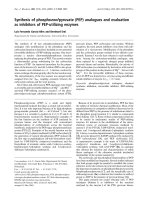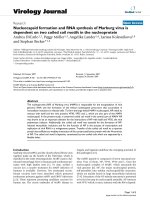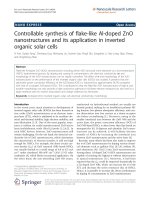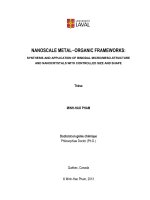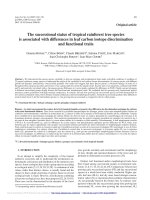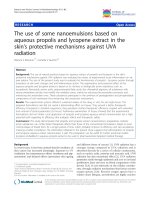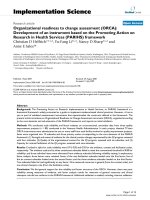Synthesis of chiral zirconium based metal organic frameworks as solid catalysts in asymmetric carbon carbon coupling reactions
Bạn đang xem bản rút gọn của tài liệu. Xem và tải ngay bản đầy đủ của tài liệu tại đây (7.25 MB, 153 trang )
Synthesis of chiral zirconium-based metal-organic
frameworks as solid catalysts in
asymmetric carbon-carbon coupling reactions
Dissertation
zur Erlangung des akademischen Grades
Doktor rerum naturalium
(Dr. rer. nat.)
vorgelegt
dem Bereich Mathematik und Naturwissenschaften der
Technischen Universität Dresden
von
M. Eng. Khoa Dang Nguyen
geboren am 19.01.1989 in Ho Chi Minh city, Vietnam
eingereicht am 20.08.2019
verteidigt am 21.11.2019
Die Dissertation wurde in der Zeit von Januar 2016 bis Dezember 2019 an der
Professur für Anorganische Chemie I angefertigt.
1. Gutachtern
Erstgutachter:
Prof. Dr. Stefan Kaskel (Technische Universität Dresden)
Zweitgutachter:
Prof. Dr. Christoph Janiak (Heinrich-Heine-Universität Düsseldorf)
2. Rigorosum
Erstprüfer:
Prof. Dr. Stefan Kaskel (Technische Universität Dresden)
für Anorganische Materialien
Zweitprüfer:
Prof. Dr. Eike Brunner (Technische Universität Dresden)
für Analytische Chemie
3. Promotionskommission
Vorsitzender:
Prof. Dr. Andreas Fery (Leibniz Institut für Polymerforschung Dresden e.V.)
Erstprüfer:
Prof. Dr. Stefan Kaskel (Technische Universität Dresden)
Zweitprüfer:
Prof. Dr. Eike Brunner (Technische Universität Dresden)
Weiteres Mitglied: Prof Dr. Thomas Doert (Technische Universität Dresden)
Acknowledgements
My PhD thesis finally come true. I never imagine that enantioselective synthesis based on chiral
metal-organic framework is the title of my research due to my left-right confusion. However, by
determining the name of enantiomers during four years, the destiny gives me one great chance to
improve myself. Although that is my nightmare at the beginning time of PhD course, beautiful
memories with my family, my friends, and my group in Deutschland help me to overcome that
difficult period. Therefore, I would like to take this opportunity to show my sincere gratitude and
appreciation to them.
First and foremost, I would like to express my sincere gratitude to my supervisor, Prof. Stefan
Kaskel, who gives me one chance to arrive to one of the most wonderful cities, Dresden, as well
as approach a high level of academic working style. My thesis would not have been finished
without his great encouragement and inspiring guidance. I have been learnt very much from his
profound knowledge during our course of interactions. Working with him, I have become more
and more mature in designing and developing academic projects.
Especial thanks have to be for Dr. Irena Senkovska. Her continuous support and encouragement
have always kept me going ahead and made me more self-confidence. She always listens and
raises the best solutions for all my troubles in work as well as routine life in “Tête-à-Tête”
meetings. I really appreciate her detailed corrections for polishing my drafts using for publications
and presentations. I am also grateful to Dr. Volodymyr Bon, who gives me the best guidance how
to use crystal visualization software in refining and constructing the structure of MOFs. I really
admire the way he “plays” with MOF structures on Materials Studio, he looks like as a true artist.
I express my heartfelt gratitude to Dr. Franziska Drache. Her friendly nature and dedicated
introduction have always made me feel at ease with the new laboratory culture as well as
experiments in my early days. I also want to thank Dr. Christel Kutzscher, Mr. Sebastian Ehrling,
Mrs. Claudia Eßbach, and Mrs. Kerstin Zechel, who are professional in HPLC, SEM, and gas
adsorption measurements. My thesis would be impossible to reach this goal without their
enthusiastic help. I am especially grateful to Dr. Bikash Garai, Mr. Ubed Sonai Fahruddin Arrozi,
and Mr. En Zhang for timely advice, constant support and cooperation.
To all members of Kaskel group, I really appreciate the time we spent together and I am very
lucky to work with you, a perfect team. I will miss you so much!
To all my friends, Mrs. Hai Yen, Dr. Hoang Phuoc, Kim Hoang, Hong Nhung, Mai Huong, My
An, Kien Pham, Dr. And Phan, Dr. Tien Le, your warmth has pushed me up and kept me smile
during my stay here. I will always cherish your friendship.
My special words of thanks should go to thầy Đưa, Prof. Nam Phan, Assoc. Prof. Nhan Le, and
all my teachers, who has made it possible for me to reach this goal. I cherish and appreciate their
kindness and fruitful knowledge, which have always inspired me.
I gratefully acknowledge the 911 project of Vietnamese Government for providing me financial
support. This not only made my PhD come true, but also provided a great opportunity to open my
mind and improve myself.
My deepest gratitude, I would like to express Mẹ, chị Tuyền, anh Hà, Quang, and my big family,
who never question my decision and always stand strongly behind my back during the tough time
of my life. Thanks you all with love!
“There can be miracles when you believe” (Stephen Schwartz)
Abbreviations
Abbreviations
Abbreviation
Description
1D
One-dimensional
2D
Two-dimensional
3D
Three-dimensional
de
Diastereomeric excess
dr
Diastereomeric ratio
ee
Enantiomeric excess
BET
Brauner-Emmett-Teller
BINAP
2,2’-bis(diphenylphosphino)-1,1’-binaphthyl
BINOL
1,1’-bi-2-naphthol
Boc
tert-butyloxycarbonyl
CP
Cross polarization
CPO
Coordination Polymer of Oslo
DFT
Density functional theory
DNP
Dynamic nuclear polarization
DUT
Dresden University of Technology
EA
Elemental analysis
EDX
Energy dispersive X-ray spectroscopy
Equiv.
Equivalent
FID
Flame ionization detector
FT-IR
Fourier-transform infrared spectroscopy
GC
Gas chromatography
HKUST
Hong Kong University of Science and Technology
HPLC
High performance liquid chromatography
ICP
Inductively coupled plasma
i
Abbreviations
IRMOF
Isoreticular metal-organic framework
MAS
Magic-angle spinning
MIL
Material of Institute Lavoisier
MOF
Metal-organic framework
MS
Mass spectrometry
NLDFT
Non-local density functional theory
NMR
Nuclear magnetic resonance
NU
Northwestern University
PCN
Porous coordination network
PXRD
Powder X-ray diffraction
RT
Room temperature
SBU
Secondary building unit
SEM
Scanning electron microscopy
TGA
Thermogravimetric analysis
UiO
Universitetet i Oslo
wt.%
Weight percent
XRD
X-Ray diffraction
ii
Table of contents
Table of Contents
Acknowledgements ........................................................................................................................ i
Abbreviations ................................................................................................................................. i
Table of Contents ........................................................................................................................ iii
Chapter 1 State of the art ............................................................................................................ 1
1.1 History of metal-organic framework ........................................................................................ 2
1.2 The art in stable zirconium-based metal-organic frameworks synthesis ................................. 8
1.3 Approaching asymmetric catalysis based on Zr-MOFs ......................................................... 12
1.3.1 Enantiopure active sites locating on organic linkers of Zr-MOFs .............................. 13
1.3.2 Enantiopure active sites coordinated to inorganic clusters of Zr-MOFs ..................... 18
1.4 Motivation .............................................................................................................................. 20
Chapter 2 Methods of characterization and Experimental section .................................... 22
2.1 Methods of characterization ................................................................................................... 23
2.1.1 Solid-state nuclear magnetic resonance ...................................................................... 23
2.1.2 Chiral high-performance liquid chromatography ........................................................ 27
2.2 Equipment and parameter ....................................................................................................... 29
2.2.1 Powder X-ray diffraction............................................................................................. 29
2.2.2 Physisorption measurements ....................................................................................... 29
2.2.3 Scanning electron microscope and Energy-dispersive X-ray spectroscopy ................ 30
2.2.4 Inductively coupled plasma atomic emission spectroscopy ........................................ 30
2.2.5 Thermal gravimetric analysis ...................................................................................... 30
2.2.6 Fourier-transform infrared ........................................................................................... 30
2.2.7 Nuclear magnetic resonance ........................................................................................ 30
2.2.8 Gas chromatography ................................................................................................... 32
2.2.9 High-performance liquid chromatography .................................................................. 32
2.3 Used chemicals ....................................................................................................................... 32
2.4 Materials synthesis ................................................................................................................. 34
2.4.1 Synthesis of DUT-67 and DUT-67-Pro ...................................................................... 34
2.4.2 Synthesis of DUT-136 and its derivatives................................................................... 36
2.4.3 Synthesis of DUT-51 ................................................................................................... 37
2.4.4 Synthesis of UiO-66 .................................................................................................... 38
iii
Table of contents
2.4.5 Synthesis of UiO-67 .................................................................................................... 38
2.4.6 Synthesis of MOF-808 ................................................................................................ 38
2.5 Catalytic studies ..................................................................................................................... 39
2.5.1 Asymmetric Friedel Craft alkylation ........................................................................... 39
2.5.2 Asymmetric Michael addition reaction ....................................................................... 39
2.5.3 Asymmetric Aldol addition reaction ........................................................................... 40
2.5.4 Nickel-catalyzed asymmetric Michael addition reaction ............................................ 41
Chapter 3 Chiral functionalization of a Zr-MOF (DUT-67) as a solid catalyst in asymmetric
Michael addition reaction .......................................................................................................... 43
3.1 Introduction ............................................................................................................................ 44
3.2 Results and discussion ............................................................................................................ 45
3.3 Conclusion .............................................................................................................................. 57
Chapter 4 Insights into the role of zirconium clusters in proline functionalized Zr-MOF
attaining high enantio- and diastereoselectivity in asymmetric Aldol addition reaction .... 59
4.1 Introduction ............................................................................................................................ 60
4.2 Results and discussion ............................................................................................................ 61
4.3 Conclusion .............................................................................................................................. 77
Chapter 5 New 1D chiral Zr-MOFs based on in situ imine linker formation for asymmetric
C-C coupling reactions............................................................................................................... 79
5.1 Introduction ............................................................................................................................ 80
5.2 Results and discussion ............................................................................................................ 81
5.3 Conclusion .............................................................................................................................. 98
Chapter 6 Conclusions and Outlook....................................................................................... 100
6.1 Conclusions .......................................................................................................................... 101
6.2 Outlook ................................................................................................................................. 103
Chapter 7 Appendix ................................................................................................................. 105
References ................................................................................................................................. 129
Publications and Presentations ................................................................................................... a
Curriculum Vitae ..........................................................................................................................c
Erklärung ...................................................................................................................................... d
iv
Chapter 1
Chapter 1
State of the art
1
Chapter 1
1.1 History of metal-organic framework
As one of the most exciting porous solids, metal-organic frameworks (MOFs) have widely
contributed to the great development of chemistry, physics, biology as well as material science
during the last three decades.1 These materials are generally constructed from various metal ions
or metal ion clusters interlinked by organic linkers in a coordination network (Figure 1.1).2, 3 It
should be noted that the term “MOFs” has also been synonymously used with other names,
including porous coordination polymers, and hybrid porous solids.4 Although, the idea of this
combination origins from the pioneer researches of Tomic, who mentioned the formation of
porous coordination polymers built from multi-functionalized organic molecules and inorganic
units in 1965, these materials did not attract much attention at that time due to their low stability.5
Figure 1.1. Schematic representation of metal-organic framework constructed from metal clusters and
organic linkers.
Up to the late 1990s, the appearance of two archetypical MOFs, namely MOF-5 (Zn4O(BDC)3)
and HKUST-1 (Cu3(BTC)2), led the explosion of studies involving these materials. An enormous
number, approximately 70000 metal-organic hybrid solids, is exemplified by reports to date
(Figure 1.2).6-8 Almost every day, novel MOF structures are being introduced as promising
materials towards a wide range of applications, including gas storage and separation, catalysis,
biomedical delivery, chemical sensing, etc.9 Contributing significantly to this great success of
MOFs is the systematic creation of crystalline powders with controlled pore size, shape, and
functionality, which could be achieved via changing the combinations of organic linkers and metal
units.10 This adjustment has been based on reticular synthesis theory, which had been mentioned
by Yaghi and O’Keeffe.11 In reticular chemistry, two components of MOFs, including both
organic and inorganic parts, have been considered as secondary building units (SBUs). By
2
Chapter 1
judiciously selecting these building blocks, MOFs can be designed following predetermined
topology.12
Figure 1.2. The number of crystalline, and non-crystalline MOF structures reported from 1980 to 2018.
Reprinted with permission from ref. 6 (Copy right 2019 Royal Society of Chemistry ).
The methodology to produce MOF-5 and its derivatives (IRMOF family) have been considered
as a benchmark illustration for the feasibility of the reticular synthesis.13 The MOF-5, also referred
as IRMOF-1, is synthesized from the reaction of Zn(NO3)2.6H2O and terephthalic acid (BDC) in
DMF solvent (Figure 1.3).12, 13 Its structure has primitive cubic (pcu) topology, constructed by
two building blocks. One is the ditopic liner linker as “strut”, while the other one is a 6-connected
octahedral cluster Zn4O(CO2)6 as the “joint”.14 Considering metal units as metal-oxo-clusters
instead of individual atoms opens the possibility to reach orderly predictable 3D structures. There
is actually a great number of possible orientations of organic linkers that may coordinate to metal
ions, and their geometry can vary during the framework formation.15 Obviously, the saturated
Zn4O(CO2)6 SBUs with six bridging carboxylate groups (COO-), have been used as perfect
guidance points with six predetermined directions.10 Moreover, the metal-oxo clusters have been
also found to play a key role in maintaining the porosity of the systems after guest molecule
removal, while 3D structures constructed from the isolated metal ions with cyano linkers in early
3
Chapter 1
Robson work tends to collapse due to their fragility.10, 16 As a result, the periodic framework of
MOF-5 provides approximately 61% empty space of its total volume after the evacuation of
solvent molecules.3, 17 Unlike any conventional porous material such as zeolites, silicates, or
porous carbon, the scaffolding-like nature of MOF-5, meaning the pore without internal walls,
provides an ideal space to adsorb gases. Nitrogen gas adsorption measurements at 77 K exhibits a
reversible type I isotherm and BET surface area of about 2300 m2/g.3 This value was a significant
breakthrough in the gas adsorption field at that time. More importantly, the pore size as well as
pore chemistry can also be easily adjusted to meet most of specific application requirement.
Toward upgrading the porosity, a new series of porous materials isoreticular to MOF-5 (IRMOF8 to 10, 12, 14, 16) was developed by replacing BDC with other increasingly complex phenylbased
ditopic
carboxylate
biphenyldicarboxylate,
linkers,
including
2,6-naphthalenedicarboxylate,
tetrahydropyrene-2,7-dicarboxylate,
pyrene-2,7-dicarboxylate,
4,4'and
terphenyl-4,4'-dicarboxylate (TPDC). The pore diameter was gradually increased from 11.2 Å
(MOF-5 referred as IRMOF-1) to 19.1 Å (IRMOF-16), and the free volume also reached up to
91.1% in the case of IRMOF-16 with TPDC linker (Figure 1.3).10,
12
Besides, the moisture
stability of material could be improved via chemical derivatization of BDC linker.18, 19 The highly
porous phase of IRMOF-1 collapses into MOF-69c in ambient air, while IRMOF-3, built from 2amino benzene dicarboxylic acid (Figure 1.3), could retain its framework structure in high
humidity environment. Furthermore, the moisture stability of IRMOF-3 could be further enhanced
by integrating long chain alkyl groups. These hydrophobic molecules could shield the 3D structure
when immersed in water.18 Altogether unprecedented properties relating to gas storage and
separation, the functionalization ability of metal-organic frameworks render them as innovative
materials. Thus for the first time, the outcome features of new materials could be predicted before
starting practical experiments.11
4
Chapter 1
Figure 1.3. Formation of some IRMOF materials and illustration of adjustment pore size as well as pore
chemistry
by
varying
the
length
and
functional
group
on
organic
building
block.
Color scheme: Zn (dark blue); O (red); C (grey); N (cyan).
The principle of the reticular chemistry is not only based on 6-connected Zn-clusters and linear
dicarboxylic acid linkers, but also expands to various metal clusters and multidentate organic
ligands.9, 20 The iconic HKUST-1, also called MOF-199 (Figure 1.4.), is a typical example. Its
octahedral cubic framework with tpo-topology is composed of benzene-1,3,5-tricarboxylate
(BTC) ligands and dicopper paddle-wheel SBU (Cu2(COO)4).8, 21 Although, the BET surface area
is only about 1600 m2/g, the existence of open copper sites in the HKUST-1 is a remarkable
property, resulting in remarkable advantages in adsorption as well as catalysis.22-24 Several
isoreticular frameworks have also been developed by using elongated tritopic linkers, such as
[4,4′,4′′-(1,3,5-triazine2,4,6-triyl)tribenzoate] (TATB – PCN-6’), and 4,4′,4′′-(-(benzene-1,3,5triyl-tris(benzene-4,1diyl))tribenzoate (BBC - MOF-399) (Figure 1.4).10 These materials show a
significant increase in cell volume from approximately 18191 Å3 for MOF-199 to 101495 Å3 for
PCN-6’ and 318765 Å3 for MOF-399.25, 26 Noteworthy, MOF-399 also records as one of the
lightest metal-organic frameworks as its density is only 0.126 g/cm3.10 Otherwise, the compound
isostructural to HKUST-1 (M3(BTC)2) could be also designed by replacing metal ions in inorganic
paddle-wheel clusters. Indeed, a wide range of structural HKUST-1 analogues could be achieved
by solvothermal synthesis with other metal sources, including Zn (II), Mo (II), Cr (II), Ni (II), and
Ru (II) instead of copper salts (Figure 1.4).3, 27 The ability to diversify metal sites without structure
change greatly contributes to the wide range practical application of metal-organic frameworks.
5
Chapter 1
Figure 1.4. Formation of isostructural HKUST-1 materials by changing metal ions or size of tritopic
carboxylate linker. Color scheme: metal (blue); O (red); C (grey).
During the next stage of MOFs development, achieving record-breaking values in surface area
has always been a special interest of many research groups to determine the limit which the MOFs
can reach.28 In a calculation model, the highest surface area of microporous hybrid materials was
predicted about 10 577 m2/g as the number of phenyl ring in organic building block reached a
maximum level to form poly(p-phenylene) frameworks.29 With simple short linkers as BDC, the
BET surface area can reach up to 4100 m2/g for MIL-101(Cr3O(H2O)2F(BDC)3) (Figure 1.6),30
while the strategy employing ligand elongation often face to the formation of interpenetrated
structures due to high symmetry of MOFs.10 Only a few of them can be synthesized in the absence
of interpenetrated phase and get extremely high BET surface area, such as 5476 m2/g for DUT-49
(Cu2(BBCDC) – BBCDC = 9,9′-([1,1′-biphenyl]-4,4′-diyl)bis(9H-carbazole-3,6-dicarboxylate)
and 7140 m2/g for NU-110 (Cu3(BHEHPI)- BHEHPI = 5,5′,5′′- ((((benzene-1,3,5-triyltris
(benzene-4,1-diyl))
tris(ethyne-2,1-diyl))
-
tris(benzene-4,1-diyl))tris(ethyne-2,1-diyl))
triisophthalate) (Figure 1.6). 28,29, 31 Therefore, building structures based on the combinations of
two linkers to decrease the symmetry of nets has been considered as a suitable approach.28
Actually, a new breakthrough has been recorded at 7839 m2/g (5.02 cm3/g – pore volume) with
the discovery of DUT-60 ((Zn4O(bcpbd))3(bbc)4), which was constructed from 1,4-bis-pcarboxyphenylbuta-1,3-diene (BCPBD) and 1,3,5-tris (4’-carboxy[1,1’-biphenyl]-4-yl)benzene
(BBC) (Figure 1.6).32
6
Chapter 1
Figure 1.6. Progress in the synthesis of ultrahigh surface area MOFs.
Although the motivation to design metal-organic frameworks derives from the basic requests for
storing gaseous fuels (natural gases and hydrogen), the progress in designing highly porous
materials expands significantly their application ranges. Based on diversity in combination of
building blocks and functionalization ability, MOFs open great opportunities to discover new
adsorption behaviours as well as develop in situ techniques for characterizing porous materials.33
Consequently, a tremendous number of reviews related to MOFs and their corresponding
applications have been published over 500 papers to date.34 However, MOFs often face to many
questions regarding their stability due to the labile nature of coordination bonds. Many of them
are in fact characterised by low thermal stability (typically below 350 ℃) or instability towards
hydrolysis.19, 35 Much efforts have been made to synthesize MOFs with enhanced stability, and
good results were obtained with the post-synthetic modification (PSM) approach, which was
introduced by Cohen and co-workers. PSM permits to incorporate a great number of
functionalities into MOF structures but the reduction in surface area and accessible porosity has
been frequently observed as a corresponding trade-off.36, 37 Therefore, many new methodologies,
which include employing azole-based ligands or high valent metal ions (Cr3+, Fe3+, Ti4+, Zr4+),
have been devoted to design directly nets with inherent stability.19 Further along the path of
synthesizing stable MOFs, the discovery of UiO-66, constructed from zirconium clusters and the
ditopic BDC linkers, has been considered as a remarkable progress. Its structure shows good
stability compared with other traditional porous materials. The weight loss of UiO-66 only starts
approximately 540 ℃ via thermogravimetric analysis. Its porous system and crystallinity have
been retained in harsh environments.35, 38
7
Chapter 1
1.2 The art in stable zirconium-based metal-organic frameworks synthesis
The robustness and reactivity of MOFs significantly rely on the strength of metal-ligand bonds,
which tend to be vulnerable toward increasing temperature or humidity. In some cases, the
structure even collapses due to vacuum treatment or exposure to ambient air. For improving the
MOFs stability, the general strategy is reinforcing the metal-ligand interactions or increasing the
electrostatic interaction between the metal ions and the ligands. This can be easily carried out by
using high valence metals with small ionic radius in preparation of metal-organic frameworks.2, 19
And, zirconium (IV) ions with high charge density are good candidates. In fact, both of Zr4+ and
carboxylate ligands are known as hard acid and hard base, respectively. As a result, the
combination of these components results in the formation of stable Zr-MOFs, which are tolerant
towards water, and even acidic or basic aqueous solutions. In addition, the high abundance, low
cost, and low toxicity of zirconium also substantially encourage the development and application
of Zr-MOFs.35, 39
The diversity of Zr-MOFs was based on the versatile geometry of Zr-clusters combined with the
tunability of multitopic organic building blocks. Although, there is a variety of polyatomic
inorganic Zr-containing clusters, the formation of Zr6O8 core predominantly appeared in Zr-MOF
structures.35, 39 In a typical Zr6(3-O)4(3-OH)4 octahedral cluster, each vertex is a zirconium
center with eight-coordination environment. The oxygen atoms form to vertices of a squareantiprismatic coordination geometry. In an ideal case, this [Zr6(3-O)4(3-OH)4]12+ cluster is fully
coordinated by twelve carboxylate groups to form the Zr6(3-O)4(3-OH)4 (CO2)12 SBU, which is
widely found in UiO-family (fcu net), such as UiO-66,-67,-68 (Figure 1.7).35, 40 Aside from 12connected Zr-clusters, the nets can be also constructed from reduced cluster connectivity,
depending on the geometry of linkers. For example, the use of an angular dicarboxylic ligand,
such as DTTDC with a bending angle of 148.61° yields 8-coordinated Zr-MOFs, DUT-51 (reo
topology) (Figure 1.7).41 In its structure, each [Zr6(3-O)6(3-OH)2]10+ octahedral cluster offers
eight of twelve coordination positions to connect 8 carboxylate groups of DTTDC linkers and 4
remaining sites are occupied by DMF and benzoate ligands. The appearance of reo structures
could be also considered as the absence of one Zr-cluster in the fcu structure or as the result of
Zr-fcu-MOFs with a missing-cluster defect site, which is a unique attribute of using bent ligands.
The other types of reduced connectivity Zr-clusters, possessing 4-, 6-, and 10- coordination
environment, have been step by step explored to enrich the Zr-MOF chemistry.42-46
8
Chapter 1
Figure 1.7. Formation of 12-,8-, and 6-connected Zr-MOFs dependent on configuration of organic building
blocks. Color scheme: Zr (green); O (red); C (grey).
However, using high charge density Zr4+ ions for stable MOFs synthesis often meets some certain
difficulties in obtaining high-quality single crystals for determining their structures.19 During
reaction, the self-repair of network defects, which origins from the lability of the bonds between
the metal ions and the carboxylate ligands, plays essential role in formation of crystalline
materials. In other words, the metal-ligand bonds at metal nodes have been formed with a relative
equilibrium, in which any disorder coordination could be replaced by corrected directional
bonds.47 In the case of high valence metals, these rearrangements slowly occur due to strong
affinity between metal ions and carboxylate ligands. The formation of either microcrystalline
powder or amorphous phase have been consequently found as an inevitable result of fast
nucleation and precipitation.35
One efficient strategy to regulate the coordination equilibrium is introducing additional chemicals
with similar functional groups as organic linkers into reaction phase. These compounds are also
termed modulators, which compete to organic linkers and slow down the reaction rate and
nucleation process (Figure 1.8).35, 46 In addition to this, the modulators have been generally
9
Chapter 1
considered as non-structural moieties, which temporarily bind to metal precursor and be released
in an exchange procedure without affecting the nets. Utilization of monocarboxylic acids, such as
benzoic acid, acetic acid, formic acid, etc. have been usually preferred in Zr-MOFs synthesis.
Together the modulation role in size, shape, and crystallinity of materials, the reproducibility of
Zr-MOFs synthesis, affected by purity of organic ligands, metal sources, or solvents, could be
further improved in the presence of monocarboxylic molecules as modulators.40, 41, 44
Figure 1.8. Formation of 12-connected Zr-MOF, UiO-66, in the presence of benzoic acid as modulators.
Color scheme: Zr (green); O (red); C (grey).
Although, the first Zr-based MOF (UiO-66), constructed from 12-connected Zr-clusters and BDC
linkers, was reported in 2008,38 its single-crystal structure determination was only successful after
another 3 years.40 Behrens and co-workers studied influence of different modulators, including
benzoic acid, acetic acid and water, on the formation of UiO-66, Zr-BDC-NH2 (UiO-66-NH2), ZrBPDC (UiO-67), and Zr-TPDC-NH2 (UiO-68-NH2). It should be noted that the size and
morphology of zirconium-based MOFs can be controlled by varying modulator concentrations.
The addition of benzoic acid played a positive role in generating the individual and bigger crystals
of UiO-66 and UiO-67, while the water present was essential for the formation of well-ordered
structures possessing amino functional groups, such as UiO-66-NH2, and UiO-68-NH2.
Especially, a mixture of benzoic acid and water as modulators enable enhancing the crystal size
of UiO-68-NH2 adapting single crystal experiment.40
Selecting rationally modulators can also lead to the change in coordination geometry of Zr-cluster
(Figure 1.9). A typical instance was observed in attempts to design isostructural DUT-51
analogues.41 Using a shortened version of DTTDC as thiophenedicarboxylate linker originally
supported the formation of the second isoreticular Zr-reo-MOF, DUT-67. However, a variety of
topologies based on Zr-TDC system could be also achieved by varying the modulator
10
Chapter 1
concentration. Particularly, DUT-68 in bon net was the result of increasing acetic acid content to
183 equiv. instead of 117 equiv. in case of DUT-67 case, while the first 10-connected Zr-MOF
(bct topology), Zr6(3-O)4(3-OH)4(TDC)5(OAc)2 – DUT-69, was achieved as 50 equiv. of this
monocarboxylic acid was applied.44 Otherwise, the nature of modulators also maintains a key role
in structure formation. This phenomenon was observed in DUT-126 synthesis as acetic acid was
replaced by trifluoroacetic acid as modulator. Consequently, an 8,8-connected binodal framework,
hbr net, was successfully introduced with an improvement in gas accessibility, pore volume of
0.48 cm3/g and BET surface area of 1297 m2/g.48
Figure 1.9. Formation of different topologies of Zr-MOF based on various modulators. Color scheme: Zr
(green); O (red); C (grey). Adapted with permission from ref.44 (Copy right 2013 American Chemical
Society).
Furthermore, the modulators crucially contribute to the formation of defect sites, which greatly
determine the nature of pore environment in Zr-MOFs.35 Varying acetic acid concentration
systematically results in the presence of missing linker vacancies in UiO-66. A decreasing
framework coordination from 12 to 11 would increase the gas accessibility of structure, which
showed an enhancement in the pore volume from 0.44 to 1.0 cm3/g and BET surface area from
1000 m2/g to 1600 m2/g,49 not only affecting the adsorption behaviour, but also the acidic property
of Zr-MOFs, origins from ligand defects and open Zr sites, which could be driven by selecting
pristine modulators. In particular, the number of defect positions in UiO-66 was mostly improved
11
Chapter 1
by adding trifluoroacetic acid during the synthesis phase. However, to generate open active sites,
the releasing of these pristine modulators by post-treatment with HCl, also played a key role in
transformation of citronellal. A similar trend was found in case of 8-connected Zr-MOF, DUT67. By post-treatment with HCl or H2SO4, the four coordination sites occupied by DMF and
acetate ions was released to form open acid centers, which efficiently catalyze the esterification.50
Obviously, the modulated synthesis based on guidance of reticular chemistry offers an efficient
approach to design rationally stable MOFs based on zirconium (IV). Despite starting as expansion
parts of the UiO-66 discovery, a vast number of Zr-MOF structures with outstanding stabilities
has been introduced in recent years.35,
46
Their appearance has ushered great possibilities to
approach practical applications. In a wide range of MOF applications, asymmetric catalysis is
perhaps one of the most fascinating topics to challenge the stability as well as diversity of ZrMOFs. Although MOF based catalysis have been known as the fastest growing fields, with less
than 20 reports in 1997 to over 1100 reports in 2007,34 using MOFs as chiral catalysts is in fact
still in its infancy.51 Only a few reports on chiral MOFs for asymmetric organic transformations
have been reported so far due to limitations in stability and remaining chiral environment around
active sites under non-ideal reaction conditions.51,
52
Therefore, Zr-MOFs with preeminent
stability have been recently emerged as promising candidates for designing efficient asymmetric
solid catalysts, which not only require appropriate enantiopure active sites, but must also be stable
enough towards exposure to reagents, solvents, and high temperature in reactions.53-56
1.3 Approaching asymmetric catalysis based on Zr-MOFs
Along with inherited basic benefits of a standard MOF supporting efficiently for catalysis,
including crystalline nature, high porosity, wide structural and functional variations, chiral
environment can be introduced on catalytic sites following various strategies on both organic and
inorganic building blocks of Zr-MOFs (Figure 1.10).51
12
Chapter 1
Figure 1.10. Representative strategies to construct MOF-based asymmetric catalysts. Reprinted with
permission from ref.51 (Copy right 2011 American Chemical Society).
1.3.1 Enantiopure active sites locating on organic linkers of Zr-MOFs
In order to realize chiral Zr-MOFs, a popular strategy is using readily available chiral ligands as
the struts of framework. This method has been inspired by efficiency of chiral auxiliaries,
employed as homogeneous asymmetric catalysts. By introducing functional groups to coordinate
to zirconium clusters, the homochirality of these precursor linkers can be transferred effectively
to resulting solid nets.51, 56
One typical example is utilization of BINOL, and BINAP derivatives to construct zirconium
hybrid materials. Lin and co-workers firstly synthesized novel chiral Zr-phosphonated
coordination polymers from BINAP structures.51 Although the zirconium phosphonate
compounds are amorphous materials due to non-crystalline nature of coordination polymers, the
immobilized Ru active sites in porous system exhibited excellent enantioselectivities for
hydrogenation of β-keto esters with above 90% ee for alkyl substitutions and about 80% for aryl
derivatives.51, 56, 57 Another series of zirconium coordination polymers based on BINOL-derived
bisphosphonic linkers was also introduced by Lin and co-workers in 2004. By integrating with
Ti(OiPr)4, these amorphous materials could promote for the transformation of aldehydes to form
13
Chapter 1
chiral secondary alcohols with good conversions and moderate ee values.58 Together with the
progresses of reticular chemistry and modulated synthesis, truly crystalline Zr-MOF (BINAPMOF), constructed from 4,4′-bis(4carboxyphenylethynyl) BINAP, in UiO topology was
successfully reported on 2015 (Figure 1.11).55 This material not only possesses a robust
framework, but also has been employed to provide chiral environment for coordinated Rh active
centers. The resulting catalysts efficiently catalyzed for the asymmetric reductive cyclization and
Alder-ene cycloisomerization with excellent performances (about 99% for yields as well as
enantioselectivities). However, they were inactive in promoting the asymmetric Pauson−Khand
reaction of carbon monoxide and cinnamaldehyde because the steric effect of BINAP structure
caused to the insufficient space for bulky reagents.55 To increase chemical accessibility of the net,
it is essential to replace partly BINAP linkers by other unfunctionalized structs of identical lengths.
As a result, another novel Zr-MOF, BINAP-dMOF isoreticular to BINAP-MOF (Figure 1.11),
was introduced and offered a better reaction space for transformation of cinnamaldehyde. In
particular, the activity of Rh-functionalized BINAP-dMOF catalyst was 10 times higher than the
homogenous control. These chiral Zr-MOFs could be reused for at least three times without
significant loss in yield and enantioselectivity.55
Figure 1.11. Structures of BINAP-MOF·Rh (left) and BINAP-dMOF·Rh (right). Reprinted with
permission from ref. 55 (Copy right 2019 American Chemical Society).
Further along the path of designing chiral Zr-MOFs with more open porosity, functionalization of
long linear achiral linkers by small chiral molecules has recently emerged as an effective
14
Chapter 1
methodology. In fact, the wealth of chiral compounds, which are accessible from chiral diene
derivatives or readily available, inexpensive as amino acids, provides a vast number of
possibilities to vary homochiral centers on predetermined Zr-MOFs structures for meeting specific
requests in asymmetric organic reactions. Elongated versions of BDC-NH2 linker are preferably
employed as carriers for assembling chiral molecules due to functional ability of amino groups.54
In a recent publication of Lin and co-workers in 2015, a derivative of BDC-NH2, namely 4,4'-((2amino-[1,1'-biphenyl]-4,4'-diyl) bis(ethyne-2,1-diyl)) dibenzoate linker, was functionalized by
chiral diene groups, and this resulting ligand could be then used to synthesize a new chiral ZrMOF in UiO topology, E2-MOF (Figure 1.12). Its pore accessibility could achieve up to 112 wt.%
in uptake of Brilliant Blue R-250. The E2-MOF after Rh metalation afforded highly efficient solid
catalysts for two asymmetric carbon-carbon coupling reactions, including 1,4-additions of
arylboronic acids to -unsaturated ketones with a TON of 13 400 ( above 90%ee) and 1,2additions of arylboronic acids to aldimines with almost perfect yield as well as
enantioselectivity.54
Figure 1.12. Representative scheme of the construction of E2-MOF. Reprinted with permission from ref.54
(Copy right 2015 - Published by The Royal Society of Chemistry).
Otherwise, amino acids are also an important chiral source, which could be applied as efficient
organocatalysts in a wide range of enamine-catalyzed reactions. Coupling of well-studied amino
acid organocatalysts such as proline enables the generation of enantiopure active sites on achiral
linear ligands as BDC-NH2 derivatives.37, 51 However, the protection of catalytic amino groups is
essential to prevent coordination to metal ions during the MOFs formation, and the protection
groups could be then released to regenerate active centers via simple post-synthesis.59 Following
15
Chapter 1
this strategy, functionalization of BPDC-NH2, and TPDC-NH2 by N-Boc L-proline, in which Lproline is protected by tert-butyloxycarbonyl group, was investigated for synthesis of UiO-67, and
UiO-68 analogues, respectively. Interestingly, the in situ deprotection of the Boc groups occurred
during the Zr-MOFs formation due to the intrinsic acidic nature of Zr4+ and Zr-clusters.
Consequently, two isoreticular chiral Zr-MOFs, UiO-67-NHPro and UiO-68-NHPro, with
different window pore size was successfully achieved without involving any post-synthetic
procedure (Figure 1.13).60 Although, no-enantioselectivity was observed as applying these
materials as heterogenous catalysts in Aldol addition of 4-nitrobenzaldehyde and cyclohexanone,
the predominant formation of syn-isomers, which are opposite compared to the reaction catalyzed
by homogenous L-proline catalyst, gave rise to an interesting phenomenon for future studies
relating the role of L-proline and zirconium frameworks with the reaction mechanism. The
competition of these catalytic activity sites will be deeply investigated in Chapter 4 to provide a
better understanding regarding their effect on reaction pathway.
Figure 1.13. Representative strategy to construct two asymmetric Zr-MOFs, UiO-67-NHPro and UiO-68NHPro. Adapted with permission from ref. 60 (Copy right 2016 American Chemical Society).
Aside from popularity of above described ligand systems, organic linkers based on chiral salen
cores, which enable the chelating of various metal ions for challenging asymmetric organic
16
